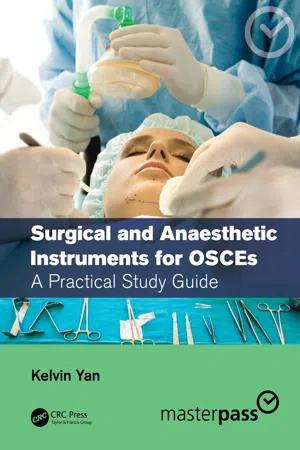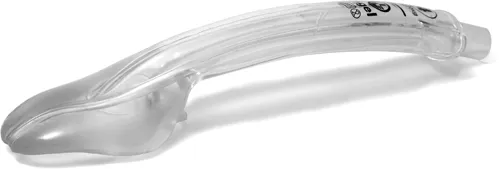
- 182 pages
- English
- ePUB (mobile friendly)
- Available on iOS & Android
About This Book
This book provides an exam-focused revision guide to both anaesthetic and surgical instruments. This is a comprehensive guide to passing an exam station and includes commonly tested knowledge.
The Anaesthetic section includes airway, breathing, circulation and analgesia equipment. Surgical instruments include those used in cardiothoracic surgery, ENT, general surgery, orthopaedics and urology. Each instrument entry follows a standard format – description, indications for use, contraindications and complications. The standard format ensures that learning about each instrument and when to use it is faster and easier, thus optimising exam recall.
- Fully illustrated with all the core anaesthetic and surgical instruments
-
- Concise, easy-to-remember text
-
- Portable and practical
-
- Suitable for a wide range of health professionals
-
The instrument syllabus is a small yet significant part of many exams, and this concise study guide will benefit a wide range of medical and surgical trainees, including those sitting the FRCA and MRCS examinations. Healthcare professionals, including nurses (ward or theatre), operating department practitioners and physician assistants (PAs), will also find the content useful as an on-the-job aide.
About the Author:
Dr Kelvin Yan, MRCP, AICSM is an NIHR Academic Clinical Fellow, University of Oxford and an Honorary Clinical Research Fellow, Imperial College London.
Frequently asked questions
Information
Part One
Anaesthetic equipment
1
Airway
- 1) Endotracheal Tube
- 2) Laryngeal Mask Airway
- 3) i-gel
- 4) Laryngoscope
- 5) Yankauer Suction Tip
- 6) Oropharyngeal Airway
- 7) Nasopharyngeal Airway
- 8) Heat and Moisture Exchanger
- 9) Tracheostomy
- 10) Intubation Fibrescope
Endotracheal Tube
What Is This?

What Are the Indications?
What Are the Contraindications?
Do You Know of Any Complications of Using This Device?
Laryngeal Mask Airway (LMA)
What Is This?

What Are the Indications?
What Are the Contraindications?
Do You Know of Any Complications of Using This Device?
How Many Types of LMA Do You Know Of?
i-gel
What Is This?

What Are the Indications?
Table of contents
- Cover
- Half-Title
- Title
- Copyright
- Contents
- Preface
- Author
- Part One Anaesthetic equipment
- Part Two Surgical Instruments
- Index